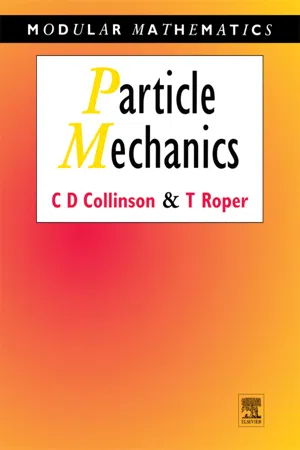Physics
Two Dimensional Polar Coordinates
Two-dimensional polar coordinates are a way of representing points in a plane using a distance and an angle. The distance is measured from the origin, while the angle is measured counterclockwise from the positive x-axis. This system is useful in physics for describing circular motion and other phenomena that involve angles and distances.
Written by Perlego with AI-assistance
Related key terms
Related key terms
1 of 4
Related key terms
1 of 3
4 Key excerpts on "Two Dimensional Polar Coordinates"
- Chris B. Jones(Author)
- 2014(Publication Date)
- Routledge(Publisher)
4.1 Cartesian and polar coordinate systems. Cartesian coordinates consist of distances measured relative to fixed axes. Polar coordinates consist of a distance from a fixed origin and an angle or angles representing direction relative to a fixed axis or to a fixed place.Positions on the earth's surface are normally defined by a geographical coordinate system consisting of degrees of latitude and longitude. This is a form of spherical polar coordinate system in which two angles are measured with respect to planes passing through the centre of a sphere or approximate sphere (spheroid) representing the shape of the earth (Figure 4.1d ). Distance is not specified in the coordinate system but it is implicit, being the radius of the earth at any given location on the surface. Because latitude and longitude refer to positions in 3D space, it is necessary for the purposes of cartography to transform them to a 2D planar coordinate system, or map grid. This type of transformation, which is called a projection, can be done in many different ways. The principal types of map projection transform from the earth's surface either directly to a plane, or to a cylindrical or a conical surface which, having been conceptually wrapped around the earth, can be unrolled to form a flat surface. When lines of latitude and longitude are plotted on the map they are referred to as a graticule (Figure 4.2 ).Figure 4.2 Geographical coordinates are a special case of spherical coordinates in which a point P is defined by an angle of latitude which is measured relative to the plane of the equator (perpendicular to the axis of rotation) and an angle of longitude which is measured relative to a plane of a datum meridian passing through the axis of rotation. The network of lines of equal longitude (meridian) and of equal latitude (parallels) constitute the graticule.All projections from geographical coordinates on the earth's surface to 2D map-grids involve some sort of distortion. The choice of projection is usually governed by a desire to minimise one or more of the distortions of either angles, linear dimensions or areas. For this reason it is important to appreciate the processes of map projection and the way in which they introduce internal changes in scale which give rise to these distortions.- eBook - ePub
Foundations of Mathematics
Algebra, Geometry, Trigonometry and Calculus
- Philip Brown(Author)
- 2016(Publication Date)
- Mercury Learning and Information(Publisher)
section 2.6 ).The mathematical methods in a two-dimensional coordinate system that we introduce in this chapter can be generalized to a three-dimensional coordinate system (although we will not do it in this book). A three-dimensional coordinate system can be used as a mathematical representation of the three-dimensional physical space in which we humans move around; and it is in this coordinate representation of three-dimensional space that mathematicians and scientists can carry out advanced mathematical simulations of dynamic processes like ocean currents, planetary weather patterns, motions of projectiles, and exploding stars.2.2WORKING IN A COORDINATE SYSTEM
Any given point in the Cartesian plane can be labeled by means of two numbers called coordinates. The first coordinate is called the x-coordinate, and the second is called the y-coordinate. The x- and y-coordinates together form a coordinate pair. The x-coordinate can be found by following a vertical line from the given point to a point on the x-axis and reading its position on the number line. Similarly, the y-coordinate can be found by following a horizontal line from the given point to a point on the y-axis and reading its position on the number line. Points in the Cartesian plane are usually labeled using uppercase letters with the coordinate values following in parentheses, as shown in figure 2.2 . The axes separate the Cartesian plane into four quadrants (first, second, third, and fourth quadrants) that can be labeled as I, II, III, and IV, respectively, in a counterclockwise order, starting with the upper right quadrant.FIGURE 2.2. Points in the Cartesian plane.2.3LINEAR EQUATIONS AND STRAIGHT LINES
Much of mathematics involves the study of related quantities in the form of equations. For this reason, we begin with a study of linear equations and the graphs (infinite straight lines) of linear equations in the Cartesian plane because these quantify the simplest kind of relationship (linear) that related quantities can have. We will refer to an “infinite straight line” (in the Cartesian plane) as a “line.” - eBook - ePub
- Sivaji Chakravorti(Author)
- 2017(Publication Date)
- CRC Press(Publisher)
Figure 3.5 .As shown in Figure 3.5 , r is the distance from the pole to the projection of the point P on the polar plane, that is, the x–y plane passing through the pole, θ is the azimuthal angle, that is, the angle from the polar axis spinning around the z -axis in counter-clockwise direction, and z is the vertical height from the polar plane. The ranges of the values of the three coordinates are 0 ≤ r < ∞, 0 ≤ θ ≤ 2π and −∞ < z < ∞.FIGURE 3.5 Depiction of cylindrical coordinates of a point.In the cylindrical coordinate system, the three constant coordinate surfaces are defined by Equation 3.9f 1= r ,f 2= θ ,f 3= z ( 3.9 )Figure 3.6 shows the three constant coordinate surfaces in the cylindrical coordinate system. Out of these three surfaces, the first and the third surfaces, namely, f 1 = r and f 3 = z , are constant distance surfaces, whereas the second one, that is, f 2 = θ, is a constant angle surface. As shown in Figure 3.6 , the surfaces θ = constant and z = constant are planes, whereas the surface r = constant is a cylindrical surface.In this coordinate system, two unit vectors are defined on the x–y plane. The unit vector ûr points in the direction of increasing r , that is, radially outwards from the z -axis and the unit vector û θ points in the direction of increasing θ, that is, it points in the direction of the tangent to the circle of radius r in the counter-clockwise sense. The third unit vector ûz points in the direction of increasing z , that is, vertically upwards from the x–y plane. The unit vectors are shown in Figure 3.5 . The orthogonality of cylindrical coordinate system is defined by Equation 3.10 - eBook - ePub
- Chris Collinson, Tom Roper(Authors)
- 1995(Publication Date)
- Butterworth-Heinemann(Publisher)
P by the equationsFig 6.1 Plane cartesian and polar coordinates.Squaring these and adding gives x 2 + y 2 = r 2 and r , being positive, is found by taking the positive square root. Assuming that r ≠ 0, expressions for cos θ and sin θ are obtained by substituting r into the two original equations. These expressions will only determine a unique value for θ if the angle is constrained to lie in an appropriate interval. Here we shall use the convention 0 ≤ θ < 2π. Each point of the plane is then specified uniquely by the values of the coordinates (r , θ), with the exception of the origin O for which the angle θ is undefined.The basis vectors î and ĵ associated with the cartesian coordinates (x, y ) are often defined as being the unit vectors parallel to Ox and Oy and directed in the positive x and y directions, respectively. This definition does not generalize to other coordinates and we prefer to define the basis vectors at each point P , î being the unit vector in the direction in which P moves when x is increased keeping y fixed and ĵ being the unit vector in the direction in which P moves when y is increased keeping x fixed. These basis vectors are illustrated in Fig. 6.2 . This definitiongeneralizes to other coordinates. In particular, basis vectors and can be associated with the plane polar coordinates (r , θ) at each point P , being the unit vector in the direction in which P moves when r is increased keeping θ fixed and being the unit vector in the direction in which P moves when θ is increased keeping r fixed. These basis vectors are illustrated in Fig 6.3 . The vectors and constitute apolar basis and the components of a given vector relative to this basis are called the polar components . The directions of and are often described by the adjectives radial and transverse , respectively, and the polar components of the vector are then referred to as the radial and transverse components
Index pages curate the most relevant extracts from our library of academic textbooks. They’ve been created using an in-house natural language model (NLM), each adding context and meaning to key research topics.
Explore more topic indexes
Explore more topic indexes
1 of 6
Explore more topic indexes
1 of 4



